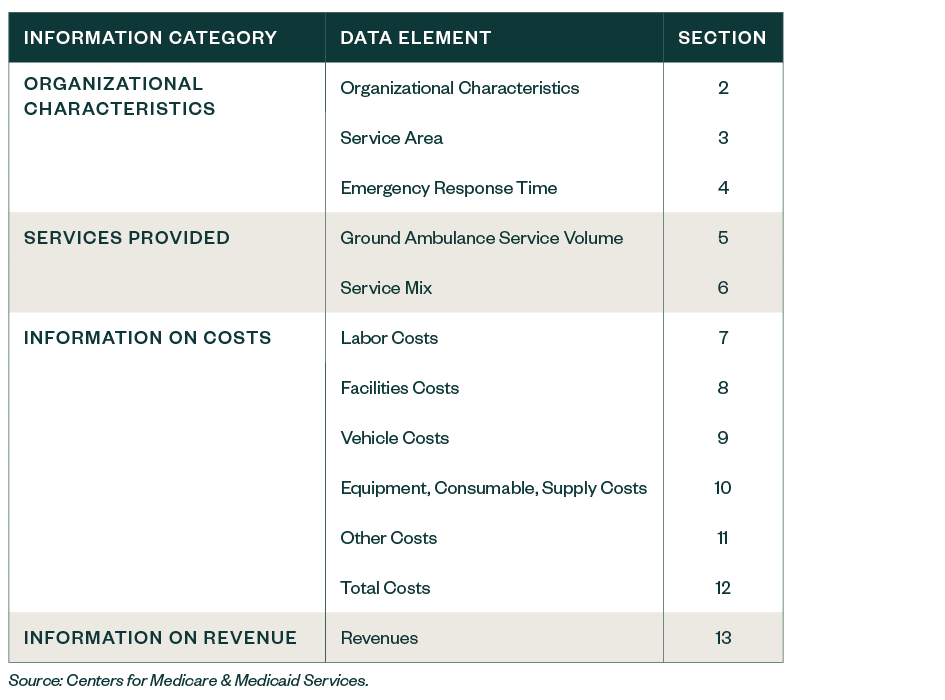The Centers for Medicare and Medicaid Services (CMS) recently released the new Medicare ground ambulance data collection system.
Key information about the program as well as considerations for reporting follows.
What Is the Medicare Ground Ambulance Data Collection System?
CMS picked ground ambulance providers to participate in the Medicare ground ambulance data collection system (GADCS), a program running January 1, 2020, until 2024.
Providers on the list must collect information on costs, utilization, revenue, and other elements for 12 months and report that data within five months after the data collection period ends.
What Is a Ground Ambulance Organization?
Simply, it’s any provider that bills Medicare for ground ambulance services. This includes land and water ambulances, but not air ambulances.
How Will the Data Be Used?
CMS will evaluate how well reported costs relate to payment rates under the Medicare Part B ambulance fee schedule (AFS) and use that information to set future Medicare payment rates, possibly raising them.
The program requires information be collected in several domains:
- Utilization of capital equipment
- Ambulance capacity
- Different types of ground ambulance services furnished in different geographic locations
Medicare has used this type of data collection in the hospital space to set different payment rates based on different geographic locations. It appears CMS may adopt this concept into the ambulance payment space.
Program Selection and Reporting Timeline
CMS has chosen representative samples of the approximately 10,600 ambulance organizations to collect data from each year.
The first year of data collection began January 1, 2022, and reporting starts in 2023. The COVID-19 pandemic pushed back the timeline two years from its initial planned start in 2020.
Participants are chosen by their National Provider Identifier (NPI) and notified by mail or email. If an organization wasn’t chosen for the first or second year, it will likely participate in the third or fourth year, and organizations are unlikely to be chosen twice, per the CMS website.
CMS posted a list of organizations selected for year one and year two in the Ambulances Services Center. Distribution of notification letters began in November 2021 and is still in progress. Monitor email and regular mail for communications from your Medicare Administrative Contractor (MAC) regarding selection.
When Will Data Need to Be Collected and Reported?
Selected organizations must collect the data over 12 months and report that data within five months after the data collection period ends. Collected data can be based on a calendar year or aligned to an organization’s fiscal year.
How Will Data Be Reported?
CMS is developing a web-based portal that will launch in late 2022. It’s completing initial user testing and expects to conduct user acceptance testing in spring 2022.
Since the data collection starts in 2022 for selected organizations, no organization will be able to report that data until 2023. CMS will share more information about the web-based portal when it's available.
Penalties for Failure to Comply
Organizations that don’t submit the required information will see a 10% reduction of payments under the ambulance fee schedule for one year unless they qualify for a hardship exemption or an informal review determines they won’t be subject to the reduction.
Also, by not contributing to data used to set future payment rates, ambulance organizations could hurt their bottom lines for more than just one calendar year.
Additional Information
There are other noteworthy items from the CMS update.
MedPAC Review
After the ambulance organization data is collected, CMS will give it to the Medicare Payment Advisory Commission (MedPAC). MedPAC will analyze the data for adequacy of Medicare payment rates for ground ambulance services and the geographic variations in costs.
Afterward, it will submit the required report to Congress and, as they typically do, issue a recommendation.
Confidentiality
Each organization’s specific responses will not be made public.
CMS will periodically release summary statistics, different respondents’ characteristics, and other relevant data from the collected information in aggregate so that individual ground ambulance organizations aren’t identifiable.
Selection Frequency
In response to concerns about organizations being selected for sampling in more than one year, CMS noted that none will be chosen in two consecutive years to the extent practicable.
CMS expects that each NPI will be selected over time but will likely only need to report information once through 2026. The contact of record at your MAC will be notified if your organization has been chosen for sampling.
Estimated Time Burden
CMS estimates that it will take 20 hours on average to collect the data over the course of the year and then another three hours to report it.
It’s unknown how CMS arrived at their estimate, but historically, there’s a large disconnect between CMS’ time estimates and the actual amount of time it will take to accurately compile and report various data elements.
For example, if an organization has multiple service lines, they’ll undoubtedly spend significantly more than 20 hours segregating costs for ground ambulance services from all the other service lines.
System Users
Each organization will need at least one person to enter data and one to certify it to complete the reporting requirements.
The data entry person will supply the requested information and the certifier will review the entered information and certify that it’s active.
Data Elements
There are 13 sections of data that can be grouped into four broad categories of information.
The data elements below will need to be collected by all ambulance organizations.

All costs related to ground ambulance services must be reported.
If the organization has multiple service lines, the data will have to be broken apart.
For the revenue category, CMS requests to know the kind of revenue received and whether it’s patient, grant, or another type of revenue.
We’re Here to Help
For more information about CMS’ guidance for ambulances and how it could impact your organization, please contact your Moss Adams professional.
For additional resources, visit our Health Care Consulting Practice.